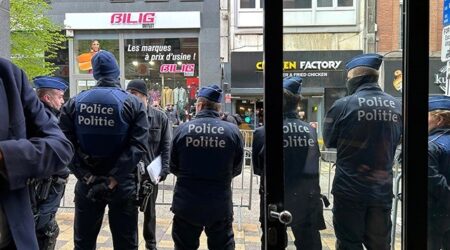The First Digital War
After World War II, most people were willing to forgive the Germans. That was because, under the Nazi regime, many Germans lacked access to accurate information. Though some of them suspected something, their brainwashed minds forced them to dismiss it as false.

It is expected that the consequences of the present Russian-Ukrainian war will be quite different, because the vast majority of Ukraine is covered by 4G or 4G LTE mobile networks.
Similar to Ukraine, Russia’s mobile networks and Internet coverage are almost 100%, at least in populated areas. Citizens of Russia have access to truthful information (or whatever remains of it during the war). Unlike postwar Germany, Russians are not likely to be forgiven this time. It will no longer be acceptable to say, “We didn’t know” or “We just followed orders.”
The Russian units had been identified before entering Ukrainian territory. Each commander had been singled out. Leaks have been reported of a database containing 120 thousand Russian soldiers and officers fighting in Ukraine. The names, addresses, passports, and military identifications of these individuals have been published. Additionally, a massive data-mining operation with open (and some illegally obtained but commonly available in Russia) sources revealed every Russian invader’s phone numbers, family members, travel patterns, photographs, friends, and parents. It has never happened before; recall that the Internet does not have a “delete” button. The world will access everything it knows about the aggressors in perpetuity. For the first time in history, the victim of the aggression makes sure that every Russian will soon google what their loved one has done in Ukraine.
Today’s generation of Russians, like the rest of the world, have no access to the names of those Soviet “liberators” who raped millions of German girls in 1945. However, the names of those Russians who raped Ukrainian girls (some of whom were under ten years old) are filed and are potentially accessible on the Internet for everyone to see. Atrocities committed by Soviet troops in “liberated” by Stalin European countries in World War II are not widely recognized but remembered by the locals. Some countries are familiar with the Russian “liberators” to a greater degree before World War II, such as Poland, Finland, and the Baltic states.
It is a matter of a state secret that the death toll of Russian soldiers is kept confidential. However, with bureaucratic punctuality, the Russian Ministry of Defense (or rather the Ministry of Offense) publishes a list of military decorations. Details such as names, DoBs, army units, etc., are included in the description. The point is that published data indicates whether a medal was awarded posthumously. There is an established strict numbering system for military decorations. The sequence of awards’ numbers with the posthumous mark provides the best estimate of Russians killed in action in Ukraine, as indirectly confirmed by the Russians themselves. That number is currently an order of magnitude higher than what Russian propaganda claims.
Shortly after the attack, local carriers canceled the registration of Russia-issued cell phones on Ukrainian mobile networks. Having robbed the local Ukrainian population of cell phones, the attackers became ecstatic that they could now contact their loved ones for free. However, nobody told them that Ukrainian intelligence has access to all phone calls via Ukrainian networks. As a result, it is the first war in which practically all communications among the “liberators” are intercepted and recorded. Moreover, all telephone calls between the invading units and their relatives in Russia were captured and documented, along with all metadata (geolocation, timestamp, and the two telephone numbers).
Ukrainian intelligence quickly traced calls made from the territory of Ukraine to Russian phone numbers. These stolen Ukrainian cell phone numbers are made into targets of the Ukrainian digital campaign designed to influence the current smartphone user (presumably a Russian soldier) to defect. Similarly, the corresponding Russian telephone numbers are intended to cultivate distrust, panic, and diverse anti-Putin narratives. Russian soldiers are receiving frightening text messages: indeed, after the war, we will find you; revenge by Ukrainians is imminent; neither you nor your family members are safe, even if you never depart Russia. One message reads, “Maybe not today, but tomorrow or in a year, you will die. We are coming after you.”
The Russians likely had world-class secure communication equipment prior to the invasion. This equipment, however, is rarely used because of a lack of training. Thus, virtually no one among the invaders uses scrambled (encrypted) communication modes. Instead, Russian crews use known radio frequencies operated by inexperienced conscripts. Ukrainian intelligence received complete knowledge of Russian operations through an open wireless exchange. At the beginning of the conflict, Ukrainian radio amateurs published known Russian military frequencies, and a worldwide volunteer army of radio amateurs jumped in and drowned Russian radio traffic in interference.
The practice was later suppressed by Ukrainian intelligence because of the importance of SIGINT information. After that, the international radio amateur community banned Russian radio amateurs from most international contests for the first time in history. At this time, Russians are still operating openly on short-wave radio and Ukrainian cellular phones. However, some are still baffled about how Ukrainian long-distance artillery batteries became aware of their precise positions.
Two factors initially shocked the world: the lack of professionalism of the Russian attackers and the significant level of professionalism of Ukrainian defenders. Today, the world is surprised that the Russians have not much tried to cover up their atrocities perpetrated on the temporarily occupied (and recently liberated) Ukrainian territories. It appears no one informed them that targeting civilians is a war crime. The fact stands that some Russians—soldiers and officers— may not have been familiar with the Geneva Convention. Furthermore, they did not have a great deal of knowledge about Ukraine: nobody in the Russian military was mindful of the Chernobyl nuclear disaster in 1986, so they foolishly dug trenches in the still-deadly radioactive forest.
The atrocities perpetrated in Ukraine are essentially unerasable. The high-resolution photographs and recorded metadata will be accepted as evidence by military tribunals after the war. For example, hackers gained access to a security camera in a Belarussian military post office and uploaded the video online. Therefore, anybody can witness for several hours what Russian marauders brought with them from Ukraine and sent to their families in Russia—from frying pans to toys to laptops to women’s underwear to toilets (including the used ones).
At this point, the war has reached a complete digital internationalization phase. Prime Minister Winston Churchill assembled a worldwide coalition to combat the Nazis over two tough years. President Zelensky used 21st-century digital technology to accomplish the same within just two weeks. Accordingly, it became the first war in which every square inch of battleground territory was filmed either from space or drones. Furthermore, it is the first war in which most firefights and post-battle dispositions were captured on cell phones and uploaded to the Internet. In other words, the current conflict is genuine, the First Digital War.
Military historians have noted for some time that in a duel between armor and a projectile, the projectile consistently prevails. The first large-scale conflict of the 21st century in Europe may produce another adage: in the end, digital truth always triumphs over digital propaganda, despite initial setbacks.
Игорь Гиндлер
www.garygindler.com





